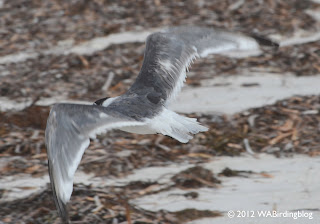Breaking a bit of a dry spell for vagrant gulls in the south-west (well, twitchable ones at least), a co-operative Franklin’s Gull has been present in the Cervantes town beach area for at least 6-8 weeks. It has mostly been seen in and around a small park outside the caravan park entrance (end of Aragon St), or on the adjacent beach, in the company of Silver Gulls.
+Alan+Collins.jpg) |
| Vagrant Franklin’s Gull Leucophaeus pipixcan on the beach at Cervantes |
Photos clearly show all the hallmarks of Franklin’s Gull: slightly smaller than Silver Gull, with darker grey upperparts; more compact body in flight; short tail with diagnostic grey centre (unique among adult gulls); well-developed black half-hood; prominent thick white eye crescents; black bill with red tip, and black legs.
 |
| Franklin’s Gull at Cervantes. Note diagnostic pale grey centre to tail, not found in any other gulls of similar size. |
 |
| Cervantes Franklin’s Gull in flight (front). Note smaller size relative to Silver Gull, noticeably darker upperparts; more compact head and body, and shorter tail. |
It appears to be in advanced pre-breeding moult with fresh inner primaries (out to p7; p8 missing), tertials, greater primary coverts, outer greater secondary coverts, and most scapulars. The secondaries are rather worn and pale and yet to begin moult. The lesser & median coverts are frayed, poorly waterproofed or possibly even oil-damaged, giving the resting wing a fairly ragged appearance. The timing of the moult seems typical: Franklin’s - uniquely among gulls - moult completely twice per year.
The modest extent of the white band separating the black primary tips on the worn p9 & p10, plus their small white spots suggest this is a second winter bird moulting into 2nd summer (~ adult-type) breeding plumage. This individual appears to be at the lower end of the range for its extent of black primary tips, given the subterminal black markings extend only to p7 as a thin line (on most Franklin’s this extends to p5 or p6, though this feature is fairly variable).
 |
| Franklin’s Gull at Cervantes. Note the small subterminal black notch on fresh p7 – these more typically extend to p5 or p6. The heavily worn outer primaries p9 & p10 (p8 is missing) show modest white tips and only a small white bar above the black ends – suggesting a 2nd winter bird moulting into 2nd summer (alternate) plumage. |
 |
| Franklin’s Gull at Cervantes. Note the fresh inner primaries, greater coverts and scapulars contrasting with heavily worn, frayed median/lesser coverts and worn paler/brownish secondaries. |
Despite the great distance from its normal migration route between North (breeding) and South America, Franklin’s Gull is perhaps the most regular of all the vagrant gull species occuring in Australia. If accepted by BARC this will be the 6th accepted record for WA, though there have been at least as many probable records rejected or not formally submitted, most recently a well-hooded bird at Vasse-Wonnerup Estuary in Feb 2009. Most WA sightings are from the Feb-April period, particularly in March.
Hat tip to the original finder, Brendan Kinsella, for sharing this great bird.
 |
| Vagrant Franklin's Gull at Cervantes. The bird has been consistently hanging around a small park next to the beach. |
 |
| Franklin's Gull on the beach at Cervantes. Note the feather moulting from the scapulars. |
 |
| Franklin’s Gull at Cervantes takes flight. |
+Alan+Collins.jpg)








No comments:
Post a Comment